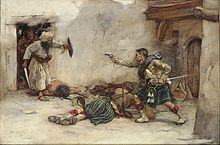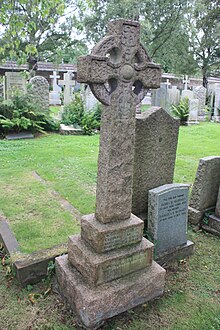William Skeoch Cumming



William Skeoch Cumming (28 December 1864 Edinburgh – 10 April 1929 Edinburgh), was a Scottish watercolourist, mainly of portraits, military subjects and Scottish Military History. Between 1912 and his death, he turned his hand to the designing and production of four large tapestries.
Life
He was the fourth son of John Cumming (1824–1908), also an artist, and Jane Skeoch, who was a cousin of
He served with the 19th Company
Cumming returned from South Africa having suffered no more than a bout of dysentery. Once home he joined the Scottish Horse
From all accounts Cumming was a cheerful person, enjoying his freedom and his music. He lodged with his elder sister and her family and only married Belle Sutton, another watercolourist, shortly before his death. His studio was at 28 Queen Street before he moved to 31 Buckingham Terrace.[2][3]
He is buried in the 20th century extension to Dean Cemetery near its centre.
References
- ^ "SS Carthaginian [+1917]". Wrecksite. Retrieved 1 October 2023.
- ^ "Biography of CUMMING, William Skeoch - Anthony Woodd Gallery". www.anthonywoodd.com. Archived from the original on 24 October 2005.
- ^ "Artworks | National Galleries of Scotland".
